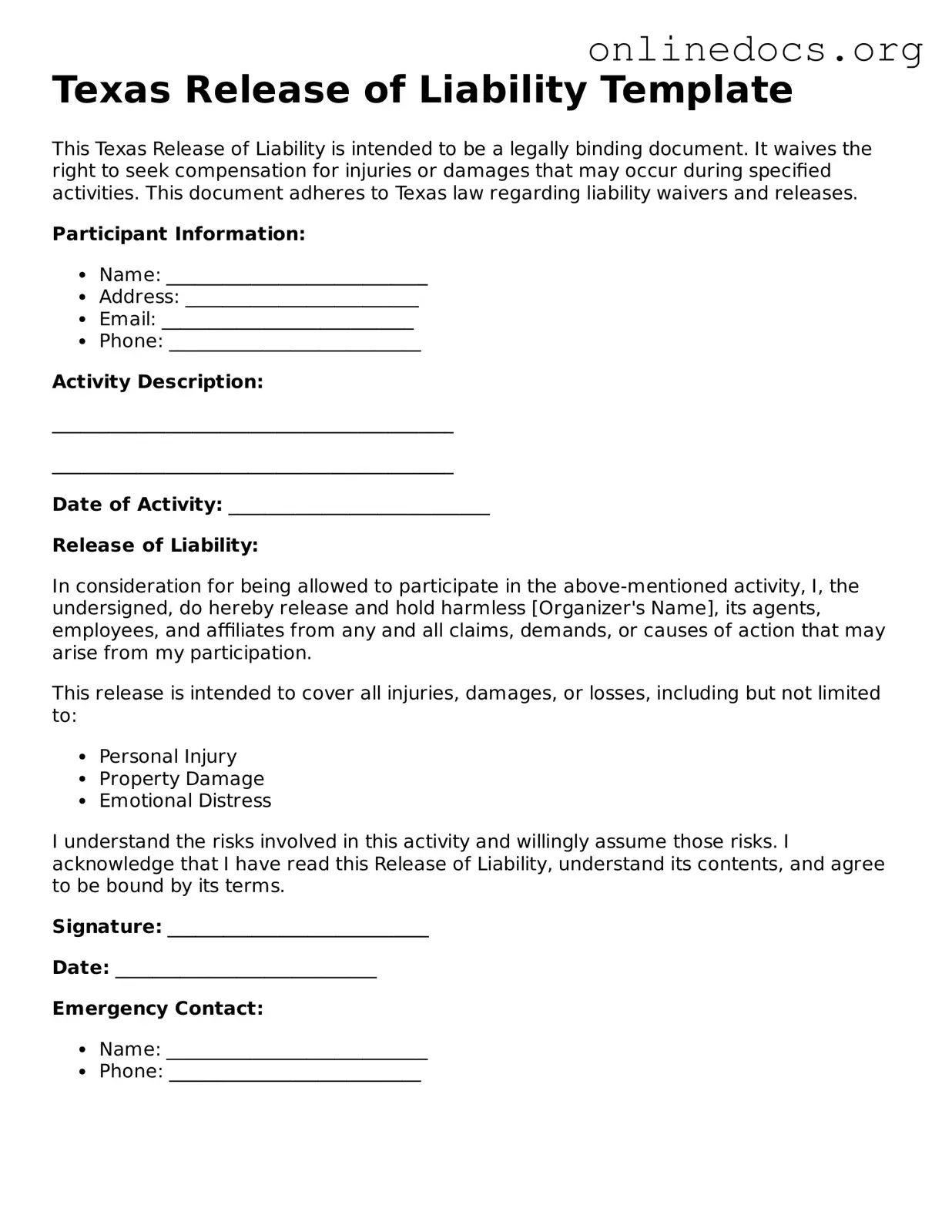The Texas Release of Liability form is similar to a Waiver of Liability. Both documents serve to protect one party from legal claims arising from the activities of another. A Waiver of Liability is often used in recreational settings, such as sports or outdoor activities, where participants acknowledge the risks involved and agree not to hold the organizer responsible for any injuries that may occur. This mutual understanding can help prevent disputes and clarify responsibilities in case of an accident.
Another document that resembles the Texas Release of Liability is the Indemnity Agreement. This agreement often involves one party agreeing to compensate another for any losses or damages incurred. In many cases, this can include legal fees and other costs associated with claims made against the indemnified party. Both documents aim to limit liability and ensure that one party does not bear the financial burden of another's actions.
The Hold Harmless Agreement is also similar. This document specifically protects one party from legal liability for injuries or damages incurred by another party. Like the Release of Liability, it emphasizes the understanding of risks involved and the acceptance of those risks by the participant. It’s often used in contracts related to events, construction projects, or any situation where one party may be exposed to potential claims.
The California Notice to Quit form is an essential document that landlords utilize to formally notify tenants of the need to vacate the rental premises. This legal notice becomes particularly important when there are issues such as lease violations or failure to pay rent. To ensure proper understanding and compliance with this process, landlords and tenants can access helpful resources, including the Notice to Quit form available at https://californiapdfforms.com/notice-to-quit-form, which provides guidance on how to effectively fill it out.
A Participant Agreement shares similarities as well. This document outlines the terms and conditions under which an individual agrees to participate in an event or activity. It typically includes a release of liability clause, making it clear that the participant understands the risks and agrees not to hold the organizer accountable for any resulting injuries. This form can be particularly useful in sports, workshops, or classes.
The Consent to Treat form is another related document. While its primary purpose is to grant permission for medical treatment, it often includes a release of liability for healthcare providers. Patients acknowledge the risks associated with treatment and agree not to pursue legal action should complications arise. This document helps healthcare providers operate with a level of assurance that patients understand their choices.
In the context of real estate, a Property Release form is quite similar. This document allows property owners to release liability for injuries that may occur on their property during a specific event or activity. It is commonly used for gatherings, parties, or events hosted on private property. By signing this form, attendees acknowledge the risks and agree not to hold the property owner responsible for any accidents.
The Event Liability Waiver is another comparable document. Often used in the context of public events, this waiver protects organizers from claims related to injuries or damages that may occur during the event. Participants must sign this waiver to acknowledge the inherent risks and agree to release the organizers from any legal responsibility. This helps ensure that the event can proceed smoothly without the fear of potential lawsuits.
A Volunteer Release form also bears resemblance to the Texas Release of Liability. This document is used when individuals volunteer for an organization, acknowledging the risks associated with their activities. By signing, volunteers agree not to hold the organization liable for any injuries that may occur while volunteering. This form helps organizations operate with confidence, knowing that volunteers understand the risks involved.
Lastly, the Non-Disclosure Agreement (NDA) can have elements similar to a Release of Liability in certain contexts. While primarily focused on confidentiality, some NDAs include clauses that limit liability for sharing sensitive information. This can provide a layer of protection for businesses and individuals, ensuring that they are not held accountable for any unintended disclosures. Both documents serve to clarify responsibilities and protect parties involved in various agreements.
